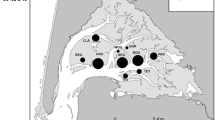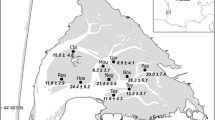Abstract
Some polyclads associate with other marine invertebrates such as gastropods, but how these associations evolve is not well understood. This study examined the relationships between a polyclad, Stylochoplana pusilla, and six species of snails in 10 eulittoral sites in Mutsu Bay, northern Japan, in 2010 and 2011. Of the six potential host snail species, Monodonta labio was present at all sites and the prevalence of S. pusilla in the snails’ mantle cavities overall was 82.6 %. Four other snail species occurred at five or six sites in comparable densities, but of these, only Chlorostoma turbinatum and Omphalius rusticus had S. pusilla in their mantle cavities (prevalence of 42.0 and 15.4 %). A congener of M. labio, Monodonta neritoides, occurred at only one site and had no S. pusilla. The mantle, which provides habitat space for S. pusilla, was proportionally the longest in M. labio. In laboratory experiments, the flatworms preferentially entered M. labio over other snail species with the same mantle length. Observed vertical distributions of snails in the littoral zone indicate that M. labio is present in the eulittoral at both high and low tides, while C. turbinatum and O. rusticus are usually found in the sublittoral. In an evolutionary sense, the relationship between S. pusilla and its host may have developed as a mechanism for the flatworm to avoid predation by living in the eulittoral and to avoid desiccation by establishing commensal relationships with certain snails.






Similar content being viewed by others
References
Branch GM, Branch M (1981) The living shores of southern Africa. C Struik, Cape Town
Brooks WR (1988) The influence of the location and abundance of the sea anemone Calliactil tricolor (Le Sueur) in protecting hermit crabs from octopus predators. J Exp Mar Biol Ecol 116:15–21
Collins AM, Gerald GW (2009) Attraction of flatworms at various hunger levels toward cues from an odonate predator. Ethology 115:449–456
Connell JH (1972) Community interactions on marine rocky intertidal shores. Ann Rev Ecol Sys 3:169–192
Dalby JE (1996) Nemertean, copepod, and amphipod symbionts of the dimorphic ascidian Pyura stolonifera near Melbourne, Australia: specificities to host morphs, and factors affecting prevalences. Mar Biol 126:231–243
Deguchi R, Sasaki H, Iwata K, Echizen M (2009) Reproduction and life cycle of the polyclad flatworm. Bull Miyagi Univ Educ 44:53–61 (in Japanese)
Faubel A, Sluys R, Reid DG (2007) A new genus species of polyclad flatworm found in the mantle cavities of gastropod molluscs in the high-intertidal zone of the Pacific coast of Central America. J Mar Biol Assoc UK 87:429–434
Fautin DG (1991) The anemonefish symbiosis: what is known and what is not. Symbiosis 10:23–46
Holbrook SJ, Schmitt RJ (2005) Growth, reproduction and survival of a tropical sea anemone (Actiniaria): benefits of hosting anemonefish. Coral Reefs 24:67–73
Houlihan DF, Innes AJ, Dey DG (1981) The influence of mantle cavity fluid on the aerial oxygen consumption of some intertidal gastropods. J Exp Mar Biol Ecol 49:57–68
Hutchinson N, Davies MS, Ng JSS, Williams GA (2007) Trail following behaviour in relation to pedal mucus production the intertidal gastropod Monodonta labio (Linnaeus). J Exp Mar Biol Ecol 349:313–322
Hyman LH (1967) The invertebrates: 6, mollusca: 1. McGraw Hill, New York
Iwai N, Sugiura S, Chiba S (2010) Prey-tracking behavior in the invasive terrestrial planarian Platydemus manokwari (Platyhelminthes, Tricladida). Naturwissenshaften 97:997–1002
Jennings JB (1971) Parasitism and commensalism in the Turbellaria. Adv Parasitol 9:1–32
Kato K (1933) On Stylochoplana pusilla Bock. Doubutugaku Zasshi 45:487–490 (in Japanese)
Kato K (1935) Stylochoplana parasitica sp. nov., a polyclad parasitic in the pallial groove of the chiton. Anno Zool Japonensis 15:123–129
Kato K (1944) Polycladida of Japan. J Sigenkagaku Kenkyusyo 1:257–318
Kato K (1965) Stylochoplana pusilla Bock. In Okada K (ed) New illustrated encyclopedia of the fauna of Japan vol 1, p 324
Lam KKY (2002) Escape responses of intertidal gastropods on a subtropical rocky shore in Hong Kong. J Mollusc Stud 68:297–306
Lytwyn MW, McDermott JJ (1976) Incidence, reproduction and feeding of Stylochus zebra, a polyclad turbellarian symbiont of hermit crabs. Mar Biol 38:365–372
Mariscal RN (1970) The nature of the symbiosis between Indo-Pacific anemonefishes and sea anemones. Mar Biol 6:58–65
Menge BA, Branch GM (2001) Rocky intertidal communities. In: Bertness MD, Gaines SD, Hay ME (eds) Marine community ecology. Sinauer Associates Inc, Sunderland, pp 221–252
Perez KO, Carlson RL, Shulman MJ, Ellis JC (2009) Why are intertidal snails rare in the subtidal? Predation, growth and the vertical distribution of Littorina littorea (L.) in the Gulf of Maine. J Exp Mar Biol Ecol 369:79–86
Prudhoe S (1968) A new polyclad turbellarian associating with a hermit crab in the Hawaiian Islands. Pac Sci 22:408–411
Reese ES (1968) Annual breeding seasons of three sympatric species of tropical intertidal hermit crabs, with a discussion of factors controlling breeding. J Exp Mar Biol Ecol 2:308–318
Ross DM (1960) The association between the hermit crab Eupagurus bernhadus (L.) and the sea anemone Calliactis parasitica (Couch). Proc Zool Soc Lond 134:43–57
Ross DM, Sutton L (1961) The association between the hermit crab Dardanus arrosor (Herbst) and the sea anemone Calliactis parasitica (Couch). Proc R Soc Lond Ser B Biol Sci 155:282–291
Schlechter V (1943) Two flatworms from the oyster-drilling snail Thais floridana haysae Clench. J Parasitol 29:362
Sreeraj CR, Ranghunathan C (2013) Pseudocerotid polyclads (Platyhelminthes, Turbellaria, Polycladida) from Andaman and Nicobar Islands, India. Proc Int Acad Ecol Environ Sci 3:36–41
Summers K, McKeon S, Sellars J, Keusenkothen M, Morris J, Gloeckner D, Pressley C, Price B, Snow H (2003) Parasitic exploitation as an engine of diversity. Biol Rev 78:639–675
Takada Y (1996) Vertical migration during the life history of the intertidal gastropod Monodonta labio on a boulder shore. Mar Ecol Prog Ser 130:117–123
R Development Core Team (2005) R: a language and environment for statistical computing. R Foundation for Statistical Computing, Vienna, Austria. ISBN:3-900051-07-0. http://www.R-project.org
Wheeler WM (1894) Planocera inquilina, a polyclad inhabiting the branchial chamber of Sycotypus canaliculatus, gill. J Morphol 9:195–201
Acknowledgments
We would like to thank Dr. Ryusaku Deguchi (Miyagi University of Education) for his invaluable information on Stylochoplana pusilla. We are grateful to two anonymous reviewers for helpful comments and suggestions on the manuscript.
Author information
Authors and Affiliations
Corresponding author
Additional information
Communicated by J. Grassle.
Rights and permissions
About this article
Cite this article
Fujiwara, Y., Urabe, J. & Takeda, S. Host preference of a symbiotic flatworm in relation to the ecology of littoral snails. Mar Biol 161, 1873–1882 (2014). https://doi.org/10.1007/s00227-014-2469-8
Received:
Accepted:
Published:
Issue Date:
DOI: https://doi.org/10.1007/s00227-014-2469-8




